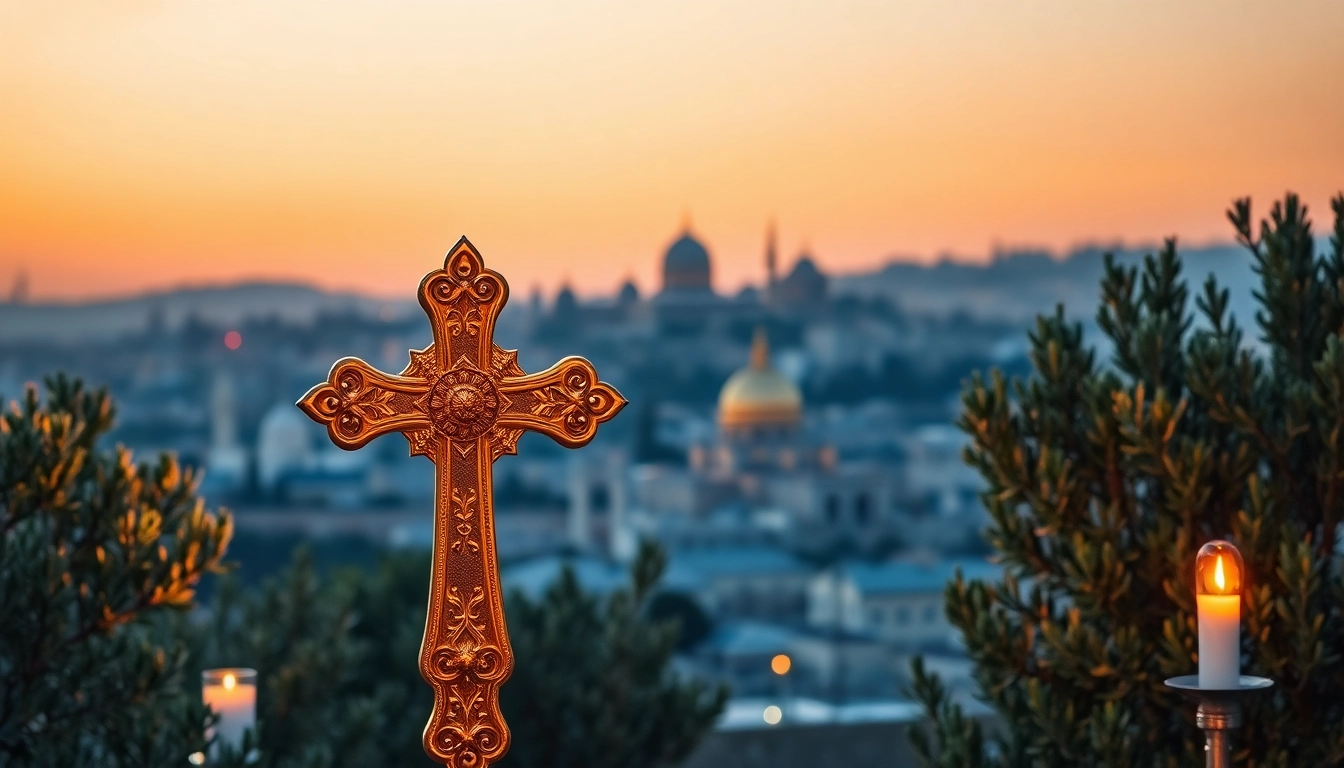Understanding Jerusalem crosses
The Jerusalem cross, often referred to as the five-fold cross or the Crusader’s Cross, is a prominent symbol within Christianity. It consists of a large, central cross that is surrounded by four smaller Greek crosses, positioned at each quadrant. This intricate design not only encapsulates a rich history but also holds significant theological meaning, representing the Four Evangelists—Matthew, Mark, Luke, and John—and the global dissemination of the Gospel. For those interested, the Jerusalem crosses symbolize a deep-rooted connection to the holy city of Jerusalem, making it a focal point of devotion and artistic expression.
Historical origins and significance
The origins of the Jerusalem cross can be traced back to the 11th century during the time of the Crusades, specifically associated with the Kingdom of Jerusalem. This emblem served not only as a representation of conquest but also as a reminder of the Christian commitment to spreading the teachings of Christ. Its heraldic design reflects the intertwining of faith and heritage, solidifying its place as a vital symbol in Christian iconography.
The Crusader’s Cross was initially popularized by the leaders of the Crusade, who utilized it as a symbol of their quest for the Holy Land. Historical records suggest that it was also adopted as the emblem of the Order of the Knights of the Holy Sepulchre, further consolidating its status as a symbol of Christian warriors. Over the centuries, it has evolved into a cherished emblem for various Christian denominations, transcending its martial origins to become a sign of faith and hope.
Design elements and their meanings
The Jerusalem cross is distinctive in its composition, comprising a large central cross with four smaller crosses situated at each corner. The design serves multiple symbolic purposes:
- The Central Cross: The main cross signifies Jesus Christ’s sacrifice and the centrality of redemption within Christian belief.
- The Smaller Crosses: Each smaller cross represents the Four Evangelists, emphasizing the importance of the Gospels in spreading Christ’s teachings. These crosses also symbolize the four cardinal directions (north, south, east, and west), signifying the universality of Christianity.
Through its layered symbolism, the Jerusalem cross presents a powerful message—a call to evangelize and share the hope found in Christ, signifying not only remembrance but also mission.
Modern interpretations and uses
In contemporary times, the Jerusalem cross has found a place in various expressions of faith and cultural identity. It is notably featured in jewelry, art, and even tattoos, serving as a personal declaration of faith for many individuals. Additionally, churches around the world incorporate this symbol in their liturgical practices, reinforcing its significance within worship and community.
The cross has also transcended religious boundaries, becoming a cultural artifact appreciated for its aesthetic qualities and historical relevance. Many artisans utilize the design in crafting exquisite pieces, celebrating both the heritage of the Jerusalem cross and its resonance with modern spiritual seekers.
The Symbolic Importance of Jerusalem crosses
The representation of Christianity
As a symbol of Christianity, the Jerusalem cross serves as an enduring reminder of the faith’s roots in the Holy Land. It embodies the hope of believers through its connection to Christ’s sacrifice and the call to spread his message. Its rich symbolism encourages Christians to remain steadfast in their faith, inspiring numerous forms of worship and artistic creativity.
Jerusalem crosses in different cultures
Across diverse cultures, the Jerusalem cross has been embraced not only as a religious emblem but also as a cultural icon. Its use can be found in various artistic movements, particularly within churches, religious literature, and cultural events that highlight the importance of Jerusalem to Christianity as well as to those of other faiths. The cross serves as a point of dialogue, inviting individuals from different backgrounds to engage in conversations about faith, history, and identity.
Emotional connection and personal significance
For many people, the Jerusalem cross represents more than just a religious symbol; it carries emotional weight and personal significance. Reflecting on its message, individuals often share stories of how the cross has been a source of strength and hope during challenging times. For some, wearing the cross as jewelry serves as a daily reminder of their faith and the teachings of Christ. Others choose to display it in their homes or places of worship, marking significant moments in their spiritual journey.
Crafting and Purchasing Jerusalem crosses
Materials used in making Jerusalem crosses
The craftsmanship behind each Jerusalem cross varies significantly based on the materials used. Traditional crosses are often made from wood, metal, or stone, with olive wood from the Holy Land being particularly revered for its connection to the region’s biblical history.
Artisans may intricately carve the crosses, adding detailed designs that enhance their beauty and spiritual significance. Some modern interpretations also explore the use of glass, ceramics, and other materials, allowing for a fusion of traditional and contemporary artistry in conveying the message of the cross.
Where to find authentic Jerusalem crosses
Finding authentic Jerusalem crosses can be both exciting and challenging. Many local artisans and shops in Jerusalem offer genuine pieces, often crafted with respect to traditional methods. Online platforms dedicated to religious artifacts also provide a wide selection of Jerusalem crosses, enabling enthusiasts and collectors around the globe to access these meaningful items.
Buying tips for collectors and enthusiasts
As demand for Jerusalem crosses rises, it is essential to discern authenticity when making a purchase. Here are a few tips for collectors and enthusiasts:
- Research reputable sellers known for their authenticity and craftsmanship. Check reviews or seek recommendations from others who share an interest in religious artifacts.
- Examine the materials used in crafting the cross. Authentic pieces typically utilize traditional materials like olive wood or metal.
- Inquire about the origin and background of the piece. A trustworthy seller should be able to provide details about the cross’s craftsmanship and story.
By following these guidelines, collectors can ensure that their Jerusalem crosses not only represent their faith but also preserve the integrity of the symbol’s heritage.
Jerusalem crosses in Art and Literature
Depictions in religious art
Throughout history, the Jerusalem cross has served as a prominent motif in religious art. Artists have portrayed it in various mediums, from paintings and sculptures to stained glass windows. Its inclusion in these works often symbolizes divine protection, spiritual authority, and the spread of the Gospel. Many religious institutions feature the cross prominently in their artwork, highlighting its significance in worship and community identity.
Literary references and influences
The Jerusalem cross has also influenced literature, inspiring authors to explore themes of faith, redemption, and sacrifice. In many texts, references to the cross serve to connect stories to the broader Christian narrative, illustrating the eternal struggle between hope and despair. As a rich symbol, the Jerusalem cross continues to inspire literary works, drawing connections between divine messages and human experiences.
Modern artists inspired by Jerusalem crosses
In the contemporary art scene, modern artists often draw inspiration from the Jerusalem cross, using it to explore themes of identity, spirituality, and cultural heritage. By reinterpreting the cross through modern techniques and styles, these artists create a dialogue between the past and present, captivating audiences with new perspectives on an ancient symbol. Their work serves as a reminder of the ongoing relevance of the cross in today’s world.
Preserving the Heritage of Jerusalem crosses
Conservation efforts for historical artifacts
As a crucial part of Christian heritage, efforts to preserve Jerusalem crosses extend beyond mere artifact conservation. Organizations dedicated to the protection of historical sites often focus on ensuring that such symbols remain a part of the cultural fabric of Jerusalem. This involves restoration projects, educational programs, and community-driven initiatives to raise awareness about the cross’s significance.
Community initiatives and cultural education
Community engagement plays an essential role in preserving the cultural significance of Jerusalem crosses. Workshops, exhibitions, and educational programs allow individuals and families to connect with the meaning behind the cross while fostering a greater appreciation for its historical context. These initiatives can help bridge the gap between generations, ensuring that the stories associated with the Jerusalem cross are passed down and celebrated.
Personal stewardship of Jerusalem crosses
To foster a deeper connection with the Jerusalem cross, individuals can take steps to become personal stewards of the symbol. This could involve documenting their own stories associated with their Jerusalem cross, educating others about its significance, or supporting local artisans who create these cherished pieces. By cultivating personal relationships with the crosses, believers can help promote their enduring relevance as symbols of faith and hope.



